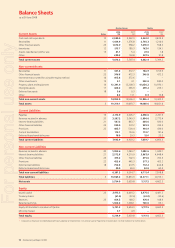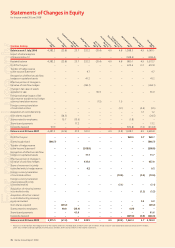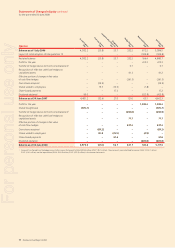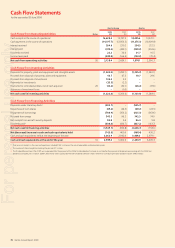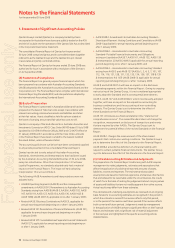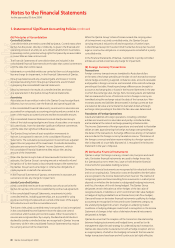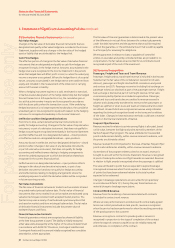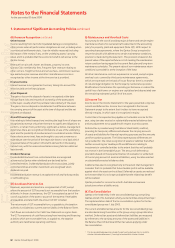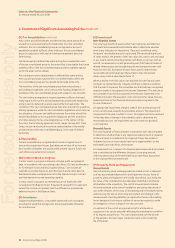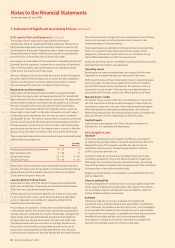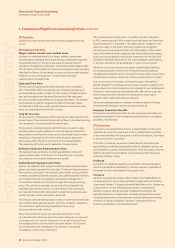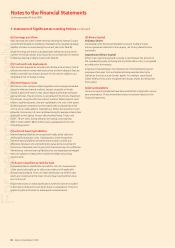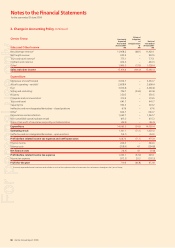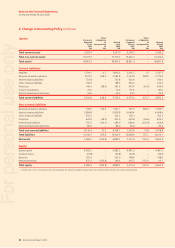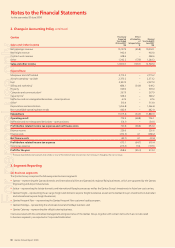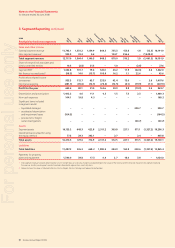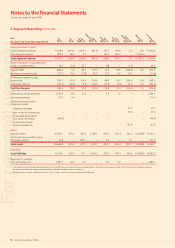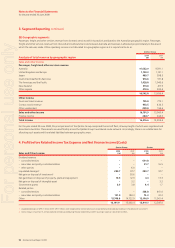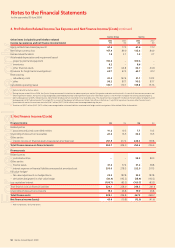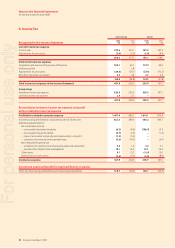Qantas 2008 Annual Report Download - page 87
Download and view the complete annual report
Please find page 87 of the 2008 Qantas annual report below. You can navigate through the pages in the report by either clicking on the pages listed below, or by using the keyword search tool below to find specific information within the annual report.
85 Qantas Annual Report 2008
(R) Payables
Liabilities for trade creditors and other amounts payable are carried
at cost.
(S) Employee Benefits
Wages, Salaries, Annual Leave and Sick Leave
Liabilities for employee benefi ts for wages, salaries, annual leave
(including leave loading) and sick leave vesting to employees expected
to be settled within 12 months of the year end represent present
obligations resulting from employees’ services provided to balance date.
The calculation of this liability is based on remuneration wage and salary
rates that the Qantas Group expects to pay as at balance date including
related on-costs, such as workers’ compensation insurance,
superannuation and payroll tax.
Employee Share Plans
The fair value of equity-based entitlements granted to employees
after 7 November 2002 is recognised as an employee expense with
a corresponding increase in equity. The fair value is estimated at grant
date and recognised over the period during which the employees
become unconditionally entitled to the equity instrument. The amount
recognised as an expense is adjusted to refl ect the actual number
of entitlements that vest, except where forfeiture is only due to share
prices not achieving the threshold for vesting.
Long Service Leave
The provision for employee benefi ts to long service leave represents the
present value of the estimated future cash outfl ows to be made resulting
from employees’ services provided to balance date.
The provision is calculated using expected future increases in wage
and salary rates including related on-costs and expected settlement
dates based on staff turnover history and is discounted using the rates
attaching to Australian Government bonds at balance date which
most closely match the terms of maturity of the related liabilities.
The unwinding of the discount is treated as a fi nance charge.
Defined Contribution Superannuation Plans
The Qantas Group contributes to employee defi ned contribution
superannuation plans. Contributions to these plans are recognised
as an expense in the Income Statement as incurred.
Defined Benefit Superannuation Plans
Qantas’ net obligation with respect to defi ned benefi t superannuation
plans is calculated separately for each plan. The Qantas Superannuation
Plan has been split based on the divisions which relate to accumulation
members and defi ned benefi t members. Only defi ned benefi t members
are included in Qantas’ net obligation calculations. Obligations of
accumulation members are accrued for as per the above accounting
policy. The calculation estimates the amount of future benefi t that
employees have earned in return for their service in the current and
prior periods; that benefi t is discounted to determine its present value
and the fair value of any plan assets is deducted.
The discount rate is the yield at balance date on Government bonds that
have maturity dates approximating to the terms of Qantas’ obligations.
The calculation is performed by a qualifi ed actuary using
the projected unit credit method.
When the benefi ts of a plan are improved, the portion of the
increased benefi t relating to past service by employees is recognised
as an expense in the Income Statement on a straight-line basis over
the average period until the benefi ts become vested. To the extent
that the benefi ts vest immediately, the expense is recognised
immediately in the Income Statement.
All actuarial gains and losses as at 1 July 2004, the date of transition
to IFRS, were recognised. With respect to actuarial gains and losses that
arise subsequent to 1 July 2004 in calculating Qantas’ obligation with
respect to a plan, to the extent that any cumulative unrecognised
actuarial gain or loss exceeds 10 per cent of the greater of the present
value of the defi ned benefi t obligation and the fair value of plan assets,
that portion is recognised in the Income Statement over the expected
average remaining working lives of the active employees participating
in the plan. Otherwise, the actuarial gain or loss is not recognised.
Where the calculation results in plan assets exceeding plan liabilities,
the recognised asset is limited to the net total of any unrecognised
actuarial losses and past service costs and the present value of any future
refunds from the plan or reductions in future contributions to the plan.
Past service cost is the increase in the present value of the defi ned
benefi t obligation for employee services in prior periods, resulting in the
current period from the introduction of, or changes to, post-employment
benefi ts or other long-term employee benefi ts. Past service costs may
either be positive (where benefi ts are introduced or improved) or
negative (where existing benefi ts are reduced).
Various actuarial assumptions underpin the determination of Qantas’
defi ned benefi t obligation and are discussed in Note 29.
Employee Termination Benefits
Provisions for termination benefi ts are only recognised when there is a
detailed formal plan for the termination and where there is no realistic
possibility of withdrawal.
(T) Provisions
A provision is recognised when there is a present legal or constructive
obligation as a result of a past event and it is probable that an outfl ow
of economic benefi ts will be required to settle the obligation, the timing
or amount of which is uncertain.
If the effect is material, a provision is determined by discounting the
expected future cash fl ows required to settle the obligation at a pre-tax
rate that refl ects current market assessments of the time value of money
and the risks specifi c to the liability. The unwinding of the discount is
treated as a fi nance charge.
Dividends
A provision for dividends payable is recognised in the fi nancial year in
which the dividends are declared, for the entire amount, regardless of
the extent to which the dividend will be paid in cash.
Insurance
Qantas is a licensed self-insurer under the New South Wales Workers’
Compensation Act, the Victorian Accident Compensation Act and the
Queensland Workers’ Compensation and Rehabilitation Act. Qantas has
made provision for all notifi ed assessed workers’ compensation
liabilities, together with an estimate of liabilities incurred but not
reported, based on an independent actuarial assessment discounted
using Government bond rates that have maturity dates approximating
the terms of Qantas’ obligations. Workers’ compensation for all
remaining employees is commercially insured.
Notes to the Financial Statements
for the year ended 30 June 2008
1. Statement of Significant Accounting Policies continued
For personal use only


